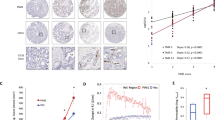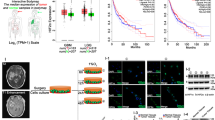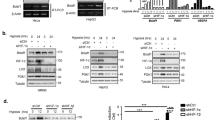Abstract
The transcription factor hypoxia-inducible factor 1 (HIF-1) plays a pivotal role in tumour growth and progression, and HIF-1 is regulated through a number of signalling pathways. Here, we investigated the involvement of the mitogen-activated protein kinase (MAPK) signalling pathway in HIF-1 regulation. We found that overexpression of wild-type (WT) extracellular signal regulated protein kinase 1 (ERK1) greatly potentiated HIF-1 activation in hypoxia and HIF-1α induced in response to insulin growth-like factor 1 (IGF-1). Conversely, treatment of tumour cells with the MEK1/2 inhibitors PD98059 or U0216, or expression of a dominant-negative form of ERK1 blocked HIF-1 activation in hypoxia without affecting HIF-1α induction, localization or binding of HIF-1β. Interestingly however, the highly selective MEK1/2 inhibitor PD184352 did not inhibit HIF-1 activity or vascular endothelial growth factor (VEGF) induced in response to hypoxia but blocked HIF-1α protein and HIF-1 activity induced by IGF-1 stimulation without affecting HIF-1α mRNA levels. Finally, we found that ERK5 phosphorylation status was not significantly affected by hypoxia in the presence or absence of PD184352. Taken together, our data suggest that although ERK1/2 signalling is important for HIF-1α induction and HIF-1 activity in response to IGF-1, it is dispensable for the induction of HIF-1α and activation of HIF-1 in response to hypoxia.
This is a preview of subscription content, access via your institution
Access options
Subscribe to this journal
Receive 50 print issues and online access
$259.00 per year
only $5.18 per issue
Buy this article
- Purchase on Springer Link
- Instant access to full article PDF
Prices may be subject to local taxes which are calculated during checkout








Similar content being viewed by others
References
Allen LF, Sebolt-Leopold J, Meyer MB . (2003). CI-1040 (PD184352), a targeted signal transduction inhibitor of MEK (MAPKK). Semin Oncol 30: 105–116.
Bardos JI, Ashcroft M . (2004). Hypoxia-inducible factor-1 and oncogenic signaling. Bioessays 26: 262–269.
Bárdos JI, Ashcroft M . (2005). Negative and Positive Regulation of HIF-1: a complex network. Biochim Biophys Acta 1755: 107–120.
Bárdos JI, Chau NM, Ashcroft M . (2004). Growth factor-mediated induction of HDM2 positively regulates hypoxia-inducible factor 1alpha expression. Mol Cell Biol 24: 2905–2914.
Berra E, Benizri E, Ginouves A, Volmat V, Roux D, Pouyssegur J . (2003). HIF prolyl-hydroxylase 2 is the key oxygen sensor setting low steady-state levels of HIF-1alpha in normoxia. EMBO J 22: 4082–4090.
Blancher C, Moore JW, Robertson N, Harris AL . (2001). Effects of ras and von Hippel–Lindau (VHL) gene mutations on hypoxia-inducible factor (HIF)-1alpha, HIF-2alpha, and vascular endothelial growth factor expression and their regulation by the phosphatidylinositol 3′-kinase/Akt signaling pathway. Cancer Res 61: 7349–7355.
Blancher C, Moore JW, Talks KL, Houlbrook S, Harris AL . (2000). Relationship of hypoxia-inducible factor (HIF)-1alpha and HIF-2alpha expression to vascular endothelial growth factor induction and hypoxia survival in human breast cancer cell lines. Cancer Res 60: 7106–7113.
Bos R, van Diest PJ, de Jong JS, van der Groep P, van der Valk P, van der Wall E . (2005). Hypoxia-inducible factor-1alpha is associated with angiogenesis, and expression of bFGF, PDGF-BB, and EGFR in invasive breast cancer. Histopathology 46: 31–36.
Carroll VA, Ashcroft M . (2005). Targeting the molecular basis for tumour hypoxia. Expert Rev Mol Med 7: 1–16.
Chau NM, Rogers P, Aherne W, Carroll V, Collins I, McDonald E et al. (2005). Identification of novel small molecule inhibitors of hypoxia-inducible factor-1 that differentially block hypoxia-inducible factor-1 activity and hypoxia-inducible factor-1alpha induction in response to hypoxic stress and growth factors. Cancer Res 65: 4918–4928.
Dokladda K, Green KA, Pan DA, Hardie DG . (2005). PD98059 and U0126 activate AMP-activated protein kinase by increasing the cellular AMP: ATP ratio and not via inhibition of the MAP kinase pathway. FEBS Lett 579: 236–240.
Fukuda R, Hirota K, Fan F, Jung YD, Ellis LM, Semenza GL . (2002). Insulin-like growth factor 1 induces hypoxia-inducible factor 1-mediated vascular endothelial growth factor expression, which is dependent on MAP kinase and phosphatidylinositol 3-kinase signaling in colon cancer cells. J Biol Chem 277: 38205–38211.
Garnett MJ, Marais R . (2004). Guilty as charged: B-RAF is a human oncogene. Cancer Cell 6: 313–319.
Harris AL . (2002). Hypoxia – a key regulatory factor in tumour growth. Nat Rev Cancer 2: 38–47.
Hockel M, Vaupel P . (2001). Biological consequences of tumor hypoxia. Semin Oncol 28: 36–41.
Hur E, Chang KY, Lee E, Lee SK, Park H . (2001). Mitogen-activated protein kinase kinase inhibitor PD98059 blocks the trans-activation but not the stabilization or DNA binding ability of hypoxia-inducible factor-1alpha. Mol Pharmacol 59: 1216–1224.
Laughner E, Taghavi P, Chiles K, Mahon PC, Semenza GL . (2001). HER2 (neu) signaling increases the rate of hypoxia-inducible factor 1alpha (HIF-1alpha) synthesis: novel mechanism for HIF-1-mediated vascular endothelial growth factor expression. Mol Cell Biol 21: 3995–4004.
Lee E, Yim S, Lee SK, Park H . (2002). Two transactivation domains of hypoxia-inducible factor-1alpha regulated by the MEK-1/p42/p44 MAPK pathway. Mol Cells 14: 9–15.
Maxwell PH, Ratcliffe PJ . (2002). Oxygen sensors and angiogenesis. Semin Cell Dev Biol 13: 29–37.
Maxwell PH, Wiesener MS, Chang GW, Clifford SC, Vaux EC, Cockman ME et al. (1999). The tumour suppressor protein VHL targets hypoxia-inducible factors for oxygen-dependent proteolysis. Nature 399: 271–275.
Mazure NM, Brahimi-Horn MC, Pouyssegur J . (2003). Protein kinases and the hypoxia-inducible factor-1, two switches in angiogenesis. Curr Pharm Des 9: 531–541.
Michiels C, Minet E, Michel G, Mottet D, Piret JP, Raes M . (2001). HIF-1 and AP-1 cooperate to increase gene expression in hypoxia: role of MAP kinases. IUBMB Life 52: 49–53.
Minet E, Arnould T, Michel G, Roland I, Mottet D, Raes M et al. (2000). ERK activation upon hypoxia: involvement in HIF-1 activation. FEBS Lett 468: 53–58.
Mody N, Leitch J, Armstrong C, Dixon J, Cohen P . (2001). Effects of MAP kinase cascade inhibitors on the MKK5/ERK5 pathway. FEBS Lett 502: 21–24.
Mottet D, Michel G, Renard P, Ninane N, Raes M, Michiels C . (2002). ERK and calcium in activation of HIF-1. Ann N Y Acad Sci 973: 448–453.
Pages G, Lenormand P, L'Allemain G, Chambard JC, Meloche S, Pouyssegur J . (1993). Mitogen-activated protein kinases p42mapk and p44mapk are required for fibroblast proliferation. Proc Natl Acad Sci USA 90: 8319–8323.
Richard DE, Berra E, Gothie E, Roux D, Pouyssegur J . (1999). p42/p44 mitogen-activated protein kinases phosphorylate hypoxia-inducible factor 1alpha (HIF-1alpha) and enhance the transcriptional activity of HIF-1. J Biol Chem 274: 32631–32637.
Sang N, Stiehl DP, Bohensky J, Leshchinsky I, Srinivas V, Caro J . (2003). MAPK signaling up-regulates the activity of hypoxia-inducible factors by its effects on p300. J Biol Chem 278: 14013–14019.
Semenza GL . (2001). HIF-1, O(2), and the 3 PHDs: how animal cells signal hypoxia to the nucleus. Cell 107: 1–3.
Semenza GL . (2003). Targeting HIF-1 for cancer therapy. Nat Rev Cancer 3: 721–732.
Sodhi A, Montaner S, Miyazaki H, Gutkind JS . (2001). MAPK and Akt act cooperatively but independently on hypoxia inducible factor-1alpha in rasV12 upregulation of VEGF. Biochem Biophys Res Commun 287: 292–300.
Squires MS, Nixon PM, Cook SJ . (2002). Cell-cycle arrest by PD184352 requires inhibition of extracellular signal-regulated kinases (ERK) 1/2 but not ERK5/BMK1. Biochem J 366: 673–680.
Suzuki H, Tomida A, Tsuruo T . (2001). Dephosphorylated hypoxia-inducible factor 1 alpha as a mediator of p53-dependent apoptosis during hypoxia. Oncogene 20: 5779–5788.
Talks KL, Turley H, Gatter KC, Maxwell PH, Pugh CW, Ratcliffe PJ et al. (2000). The expression and distribution of the hypoxia-inducible factors HIF-1alpha and HIF-2alpha in normal human tissues, cancers, and tumor-associated macrophages. Am J Pathol 157: 411–421.
Teicher BA . (1994). Hypoxia and drug resistance. Cancer Metastasis Rev 13: 139–168.
Ueda T, Watanabe-Fukunaga R, Fukuyama H, Nagata S, Fukunaga R . (2004). Mnk2 and Mnk1 are essential for constitutive and inducible phosphorylation of eukaryotic initiation factor 4E but not for cell growth or development. Mol Cell Biol 24: 6539–6549.
Wallace EM, Lyssikatos JP, Yeh T, Winkler JD, Koch K . (2005). Progress towards therapeutic small molecule MEK inhibitors for use in cancer therapy. Curr Top Med Chem 5: 215–229.
Zagzag D, Zhong H, Scalzitti JM, Laughner E, Simons JW, Semenza GL . (2000). Expression of hypoxia-inducible factor 1alpha in brain tumors: association with angiogenesis, invasion, and progression. Cancer 88: 2606–2618.
Zhong H, De Marzo AM, Laughner E, Lim M, Hilton DA, Zagzag D et al. (1999). Overexpression of hypoxia-inducible factor 1alpha in common human cancers and their metastases. Cancer Res 59: 5830–5835.
Acknowledgements
We thank Professor Paul Workman and Dr Veronica Carroll for critical review of the manuscript. We thank Professors Richard Marais and Caroline Springer (The Institute of Cancer Research, UK) for helpful discussions and input. We also thank Julia Bárdos and all other members of the Ashcroft lab for their input and support. This work was funded by The Institute of Cancer Research and Cancer Research UK (CUK) Programme Grant Number C309/A2187.
Author information
Authors and Affiliations
Corresponding author
Rights and permissions
About this article
Cite this article
Sutton, K., Hayat, S., Chau, NM. et al. Selective inhibition of MEK1/2 reveals a differential requirement for ERK1/2 signalling in the regulation of HIF-1 in response to hypoxia and IGF-1. Oncogene 26, 3920–3929 (2007). https://doi.org/10.1038/sj.onc.1210168
Received:
Revised:
Accepted:
Published:
Issue Date:
DOI: https://doi.org/10.1038/sj.onc.1210168
Keywords
This article is cited by
-
Targeting SYK of monocyte-derived macrophages regulates liver fibrosis via crosstalking with Erk/Hif1α and remodeling liver inflammatory environment
Cell Death & Disease (2021)
-
GPER mediates the angiocrine actions induced by IGF1 through the HIF-1α/VEGF pathway in the breast tumor microenvironment
Breast Cancer Research (2017)
-
Inhibition of the hypoxia-inducible factor pathway by a G-quadruplex binding small molecule
Scientific Reports (2013)
-
Monitoring Therapy with MEK Inhibitor U0126 in a Novel Wilms Tumor Model in Wt1 Knockout Igf2 Transgenic Mice Using 18F-FDG PET with Dual-Contrast Enhanced CT and MRI: Early Metabolic Response Without Inhibition of Tumor Growth
Molecular Imaging and Biology (2013)
-
Ras regulates interleukin-1β-induced HIF-1α transcriptional activity in glioblastoma
Journal of Molecular Medicine (2011)



